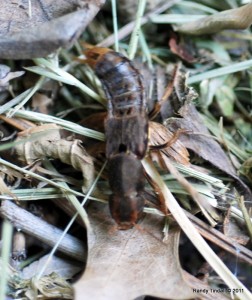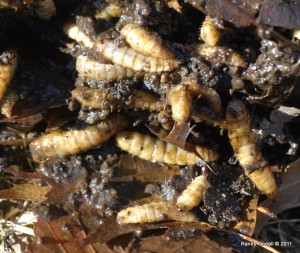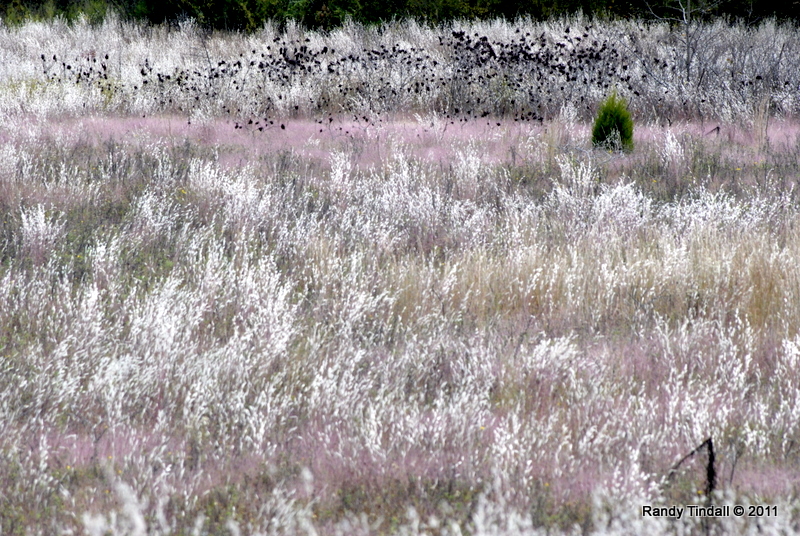It was waaay past time to turn the compost in our backyard.
One of those jobs that seem much worse in anticipation than they actually are, turning compost is something I can put off for a very long time. Now, I know that our kitchen and yard cast-offs become usable soil much, much faster if I’m actually paying attention, but somehow that doesn’t stop me from letting them find their own path. After all, no matter how much we put in them, the bins never fill up, and they don’t smell bad (until I take the lid off and put my head right down there). All that stuff is going somewhere just fine all on its own.
But today was the day. I was going to turn that compost, come hell or high water. So I popped off the bin lids, unlatched the two halves of the bins and pulled them apart. Reassembling them a few feet away, I turned back to the pile, garden fork at the ready, and prepared to shovel and layer the contents back into the containers, alternating chopped up leaves, kitchen gunk, and soil from disused plant pots, all with a sprinkle of water here and there.
A cloud of gnats milled around in confusion. Honey bees, yellowjackets, and a couple wasps looked around, annoyed at having their lunches of old fruit disturbed. I took a forkful of the stuff and slung it into the bin I’d just moved, noting the herds of pill bugs and wrigglings of worms in the composting mass. A few feet away, a Carolina wren watched intently and sang out its opinion. I wondered just what its interest was in these proceedings.
I noticed some frantic motion in the leaf litter next to the bin and crouched down to see what the fuss was (yes, it can take hours to actually accomplish anything in our backyard). I watched as what seemed to be a young june beetle engaged in titanic battle with a sinuous, writhing creature that looked as if it should be snarling and snapping its teeth. It startled me, but I grabbed my camera and squeezed off a few motion-blurred pictures before the june beetle escaped and launched skywards, and its attacker disappeared. I mean, it disappeared. I sifted through the leaf litter, but it was gone, so fast that it just seemed to pop out of existence. I later found out it was a rove beetle.
I went back to work, trying not to inflict any more damage than necessary on the denizens of the compost—I mean, if I was doing this correctly, they wouldn’t be here in the first place, right? I kind of felt responsible, but I could only do so much. Ants scurried around, frantically trying to evacuate tiny, white eggs from their nursery. Unnamed things squirmed around in the wetter parts of the mass. I still don’t know what they were.
Centipedes flowed in retreat. Seedlings sprouted everywhere, some clearly cucurbits of some kind, probably winter squash volunteers, and little tomato plants thrived. Some yard clippings we’d tossed in had grabbed on and resprouted from the cuttings, probably having a good chuckle in the process. Let’s not even get into the microscopic melee that must have been going on in there.
I had read somewhere that good compost is a living thing, compared to the more sterile soils saturated with thingacides and artificial fertilizers. If that is true, this compost was beyond good. It was angelic.
The special combination of our backyard environment, nestled in the greater environment around it, with our own blend of dietary and yard-grooming side-products, choice of sites, composting technique (or lack thereof), patterns of sun and shade throughout the day, and a thousand other variables had resulted in something that probably existed in all its detail nowhere else. It was indeed a unique ecosystem.
Oh, no. Now I’d done it.
I thought of all the hundreds, probably thousands, of articles, letters, presentations, and tv and radio shows I’d digested where someone tugged at my heartstrings and begged for help in preserving a place because it was, well, unique.
I pondered this for a moment, looking down at our little mound of incipient soil, teeming with a community we’d created, and thought: Well, yeah. What isn’t? I mean, we’ve apparently just broken the 7 billion unique-people-on-the-planet barrier, so how rare is the quality of uniqueness? Not very rare at all. In fact, it’s pretty damned universal, and you might even say it’s an inherent quality of pretty much everything, at least everything living or sculpted by natural processes. Maybe everything period. So there I was, staring at food scraps and bugs, trying to parse the strangeness of the word “unique”. I’m still trying.
So now what to do? What were my obligations here? Should I leave our own little pile of uniqueness undisturbed? Or keep going and change it into something else that would also be unique? I had to ask myself just what the property of “uniqueness” had to play in this decision at all? Are there degrees of uniqueness or a uniqueness index? If so, how does the uniqueness of our compost pile compare to that of, say, Sand Prairie Conservation Area in the Missouri Bootheel?
I suppose that one could argue that each strip mall dotted across our fair land is unique, even if they contain a pretty similar mix of fast food mills, gas stations, payday loan casinos, and car dealerships. They are somehow unique and ubiquitous at the same time, but to me they score pretty low on any potential scale of desirability. I’ve never known anyone to say, “I’m driving a couple hundred miles southeast today, because I heard there’s a really great strip mall down that way.” Would I send donations or join a demonstration to preserve a strip mall? Ahem.
However, I would do these things for a sand prairie. But why?
It seems to me that if a developer took a sand prairie, paved it over and replanted it with MacBurgerBees and other species of the strip mall ecosystem, something profound would be gone. And as much as I try to escape it, the word “unique” keeps rearing its head. But so does the word “diversity”.
There are other sand prairies, scattered among several states, but they are not nearly as much alike as are strip malls. One sand prairie is made up of very different components than the next, and there are not nearly as many of them. People do travel to see them and experience their differences. People have even been known to travel to see different types of compost piles, although not ours. The phrase “sand prairie” (insert your own favorite ecosystem type here) contains much more diversity than does the phrase “strip mall”.
Maybe we need a new or different vocabulary, especially when trying to preserve something of which there is less and less, against the encroachment of something of which there is more and more (but makes more money!). Maybe a better word is “special”.
When there are myriads of sand prairies and only a handful of strip malls left, maybe I’ll consider applying this argument to the malls.
Nah.
I turned that compost, put the bins back together and cleaned up. That compost was still unique, in its own way. But special? Not so much.




